|
July 30
Moving Day!
We got our wakeup call at 5:30,
starting early because we had a long way to travel. There was a
bit of grumbling, but as we were going to bed by ten o'clock each
evening, even with the early rising we were getting plenty of
sleep. Mosa had breakfast ready at six, and Open and KP had half
the tents taken down by the time we had finished eating. They
would pack up everything and make the long drive to the next
campsite in time to have it all set up before 6:00 p.m. when we
were due to arrive.
We were on the road by 6:30,
with the baggage trailer in tow. The sky was filled with the
pastel colors of a splendid sunrise. A mother giraffe with a baby
walked across an open field, and a herd of wildebeests meandered
by in the distance. A black-backed jackal stopped to drink from a
nearby waterhole, and was soon joined by another; with broad black
stripes on their backs and reddish-brown foxlike faces, they were
exquisite.
|
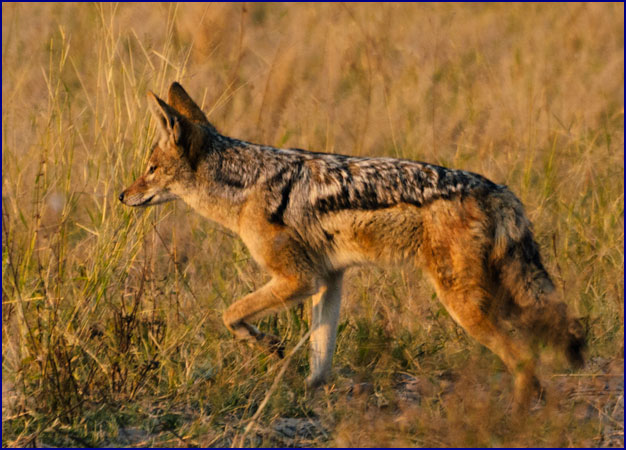
Black-backed Jackal |
The birds were making a ruckus out on the plain; Gee said
their distress could be a sign of a predator. We waited a while
but never did see what had disturbed them. We did get a good close
look at a grey hornbill though, much less common than the red and
yellow billed varieties. And speaking of birds, Sally was now up
to 170 for her trip list - this morning she added the desert
cisticola, the sabota lark and the lizard buzzard, among others.
We stopped by the Buffalo Buffet. Most of the lions were
sleeping by the road, and incredibly, some were still eating –
or more probably, eating again.
Most of the others seemed to have gorged themselves to the point
of semi-consciousness. Two youngsters were licking one another,
washing each other’s faces. A lioness got up and stood by the
signpost, and one of the boys entertained himself by chewing on a
stick. Not far away, we found the big male lion beside a pond,
fast asleep along with one of his lionesses. Their bellies were
distended; it was clear that the male had finally found his family
– and breakfast.
There were several
beautiful giraffes near the road. We had stopped to photograph
them, when suddenly, inexplicably, a white-bellied sunbird flew
down and perched on the hood of the land cruiser. The stunning
little bird was iridescent in the sun, with a long curved bill for
sipping nectar. Then it flew up and hovered like a hummingbird
just beside the vehicle, before swooping back down to sit on the
windscreen. Normally the sunbirds are elusive, and so far we’d
mostly had brief glimpses of them with binoculars deep in the
bushes – and now one was perched on our hood! Gee was as amazed
as the rest of us; he said he’d never seen that before. He had
commented earlier that it was only a good bird photo if you could
see the gleam in its eye- we were certainly close enough for that!
|
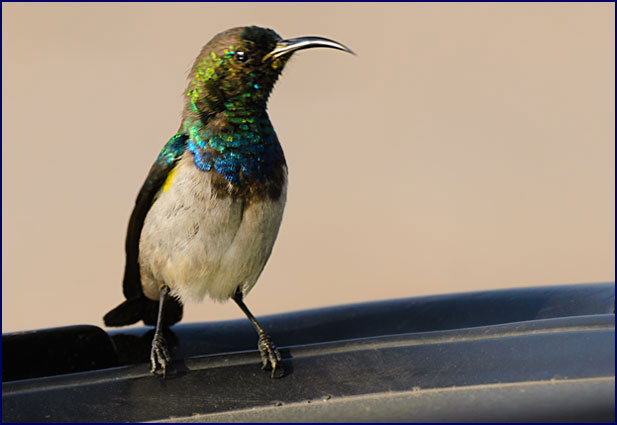
White-bellied
Sunbird
|
There were plenty of
animals around this morning. We could see giraffes, warthogs,
impala and tsessebe all from one spot. Two giraffes stood
broadside to us with their necks crossed, looking a bit like a push-me-pull-you.
We stopped for a tea break, enjoying the company of the giraffes.
There were some
beautiful birds at our tea spot. A Burchall’s starling perched
in a tree, his glossy feathers a brilliant dark blue in the sun. A
fork-tailed drongo lit on a twig nearby. A coucal looked down at
us from a thorny tree. Guinea fowl and francolins scurried through
the underbrush.
|
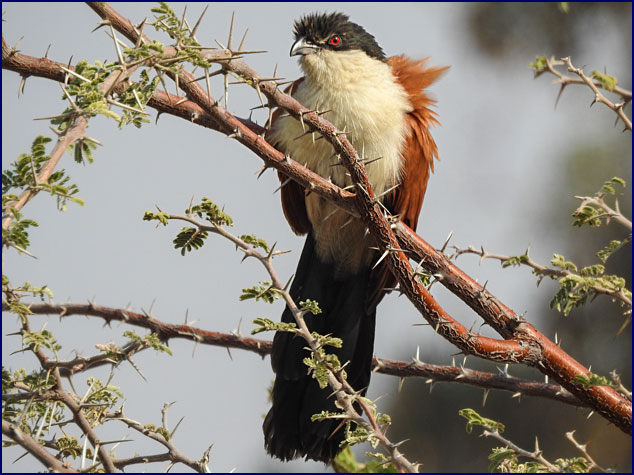
Coucal
|
Leaving the area and
heading for our next camp, we had a very long drive through the
vast Savuti Marshes. There was a fringe of forest on our right,
but on the left was nothing but barren plain as far as you could
see, accented by the silvery trunks of dead trees. Somehow I had
always thought that marshes were wet, but this seemed more like a
desert! Gee explained that the Savuti Marsh, part of what is known
as the Mababe Depression, is flooded during the rainy season. But
in 1984 shifts in the tectonic plates cut off the water supply, so
for the next 22 years it did not flood at all. Then in 2006 there
was another seismic shift and the flood waters returned; the trees
that had grown during that dry period were drowned by the
returning waters.
An eagle perched in a tree near
the road, and as we approached it took flight. Gee trained his
binoculars on the bird, trying to determine whether it was a tawny
eagle or a Walburgh’s eagle. Using my new camera with the high
powered zoom I took a close-up picture with the lens set at 800 mm
as it soared high overhead. ‘Amazing,’ Gee proclaimed, and was
able to confirm it as a tawny eagle from the tail markings in the
photo.
|
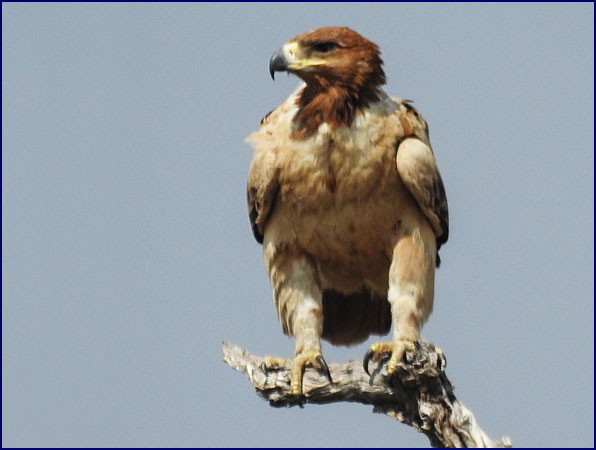
Tawny Eagle |
We saw almost no
wildlife as we crossed the waterless marshes. The barren terrain
was interesting, but soon became a bit monotonous. The dry swamp
was covered with golden-brown grasses and low thorny thickets.
Once in a while we passed a lone tree. We saw a few birds, but
most of them were LBJs. It was a warm day and there was no shade;
it was comfortable as long as we were moving, but got quite hot
when we stopped to identify birds. For the first (and only) time
we questioned the wisdom of taking the canvas roof off of the land
cruiser. It seemed to take forever to cross the marshes, but I
enjoyed the journey. Crossing this vast open expanse I felt truly
a part of quintessential Africa.
After a long while
with no animals in sight, we finally saw several warthogs. We were
back in business! Then we passed a group of shy giraffes.
Hornbills, magpie shrikes and roller birds swooped alongside the
land cruiser as we drove.
|
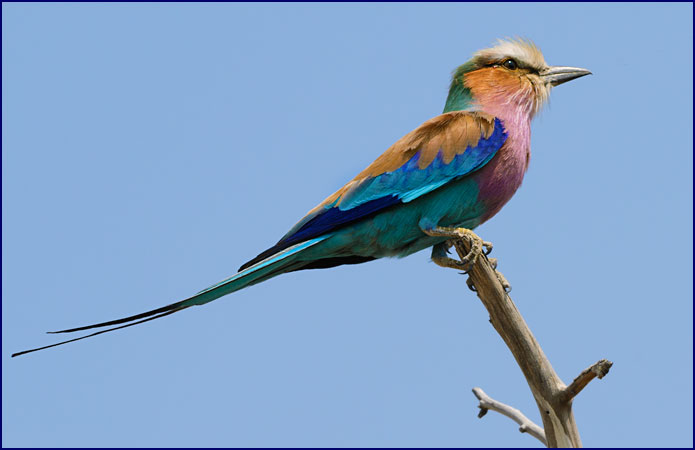
Lilac-breasted
Roller
|
The lilac-breasted
roller is indescribably beautiful, displaying at least 12
different colors. When they fly you can see the brilliant
turquoise color on their wings. I made a concerted effort to get a
decent photo of one in flight, which is harder than you might
think. Every time we passed a roller perched on a branch in good
light Gee would stop the vehicle and I would focus my camera. Then
I would wait, fingers poised on the shutter and holding my breath,
ready to catch the shot when it flew . . . . dang they are quick -
missed it again! Another empty twig photo.
|
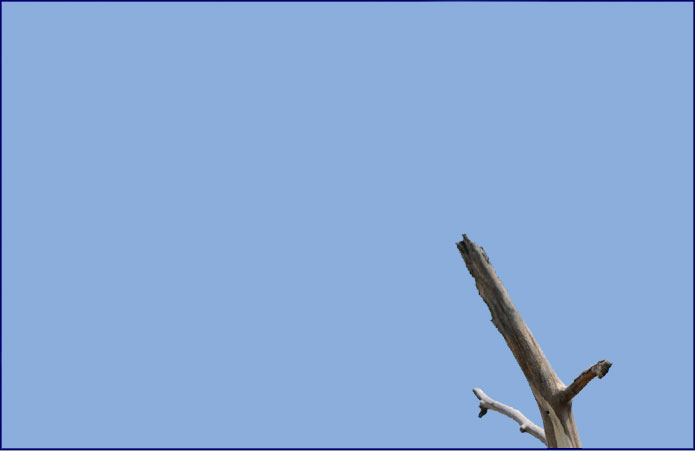
Lilac-breasted
Roller in flight |
Gee had planned to
stop for a picnic beneath two tall trees that stood in the middle
of the open dry marshland, but when we arrived it was already
occupied – by tsessebe. A dozen of these attractive antelopes
loitered in the shade. There was another large tree several
hundred yards away, so we lunched there instead.
We took an hour and a half lunch
break. I walked around a bit, exploring and taking photos. The
tsessebe gazed at us from beneath the trees with intelligent
expressions. Gee cautioned me not to go any closer because it
might cause them to leave the shade; he was always very careful
that we did nothing to disturb the natural order. Through
binoculars I could see the oxpeckers perched on them; of course
they really should be called tsessebe-peckers.
|
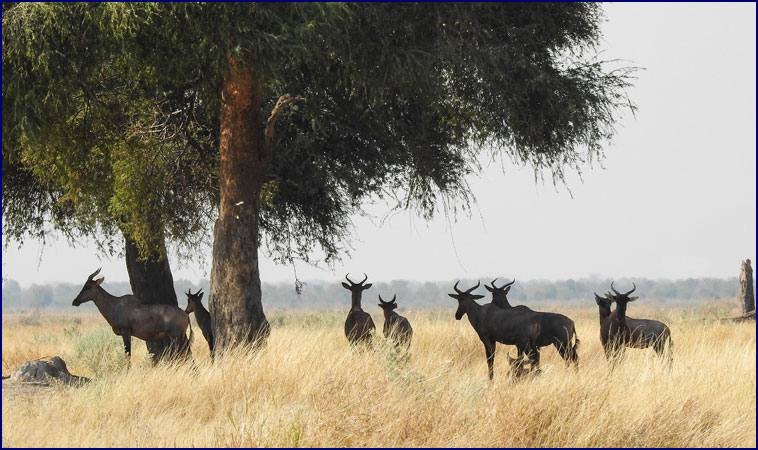
Tsessebe at lunch
|
The shade of the tree
was heavenly, and it felt good to stretch our legs. Mosa had
prepared an excellent lunch for us, and we served ourselves
buffet-style. A very bold yellow-billed hornbill flew down from
the tree and hopped about our feet - he reminded us of Zazu from The
Lion King. He had a curved yellow bill way too large for his
body and long seductive eyelashes that gave him a beguiling
expression. He was hard to resist as he tilted his head and begged
for a handout, so we broke the cardinal rule of not feeding the
wildlife and shared our lunch with him. (It was evident from his
response that we were not the first people to do so.) He really
liked the raisins from our salad but was not impressed with the
carrot strips. He was quite the attentive husband; when we gave
him a scrap of bread he flew up into the tree and fed it to his
mate. Chivalry is not dead.
|
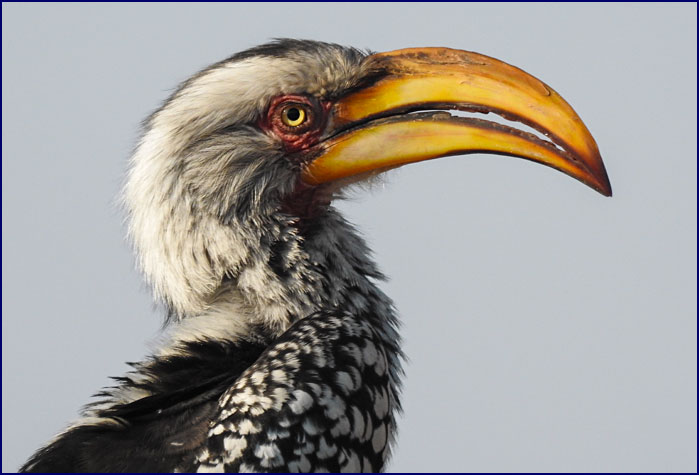
Yellow-billed
Hornbill |
A
flock of weavers occupied the tree we were sitting under, filling
the air with birdsong. We sat in the camp chairs, relaxing,
dozing, and just soaking up the essence of Africa. George got out
his watercolors and painted in his sketchbook, and I wrote in my
journal.
All too soon it was
time to move on, and we were on the road again at three. Before
long the most barren part of the swamp was behind us; there were a
lot more trees and we soon started seeing more animals. We passed
a family of warthogs, running along with their tails straight up
over their backs. A single wildebeest lay sleeping under a
tree. Impala and buffalo grazed, and we saw a family of giraffes
and some elephants in the distance.
Presently we came to the gate of
the Khwai Community Concession, where we were to camp for the next
three nights. It had been a long day of driving - Gee had taken it
slow so we wouldn’t arrive in camp before six, to give the guys
time to set it up.
We were back into forested land,
and the road once again dwindled to mere tire tracks through deep
heavy sand. We passed a ‘five-legged elephant,’ a huge bull
having a pee right beside the road. By contrast a bit further on
we saw a tiny delicate steenbok. What wonderful diversity there is
in the world.
|
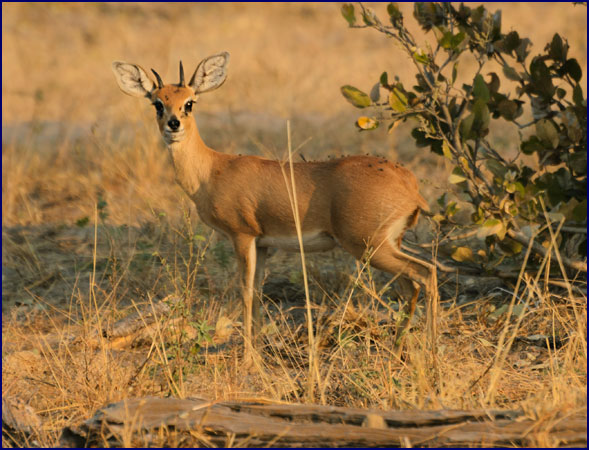
Steenbok
|
At
last we came out on to the Maun Road; it was a proper gravel road
instead of a dirt track. The trees along it were coated with a
heavy layer of a fine white dust, and everything was surreal, like
a moonscape. Gee sped along at upwards of 30 mph, and those of us
in the back put our heads down and covered our faces to avoid
breathing in the great clouds of dust that billowed up from the
road as we passed. George spotted a hyena walking among the
dust-covered bushes beside the road.
|
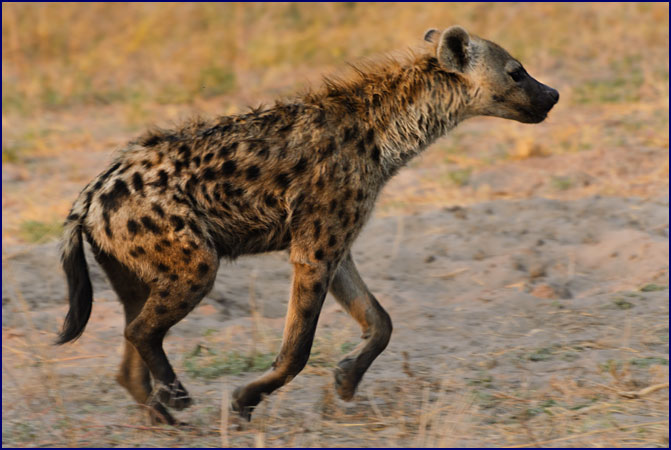
Hyena
|
After a while we turned off on a narrow track through the
forest. We stopped by a channel of water; we were on the outer
fringe of the Okavango Delta. Gee explained that the waters that
flood the delta come from rains in Angola, thousands of miles to
the north.
We drove along beside a small
river. A fish eagle flew before us, and hippos peered at us from
the water. The Khwai area seemed incredibly lush compared to the
dry barrenness of the Savuti Marsh. We passed several pools and
channels where the surface of the water was completely choked with
duckweed, appearing like solid ground - Gee said this was an
invasive species from Asia, carried from pool to pool on the backs
of the hippos.
We crossed an open field where
zebras, waterbucks and kudus grazed, and at the edge of it was our
camp. Open greeted us with glasses of ice tea when we arrived. Our
tents were under a grove of huge trees, laid out very much like
before, forming a semi-circle with the dining tent and campfire in
the center. We couldn’t see the river, but we could hear the
laugh-like voices of the hippos - we couldn’t help cracking up
each time we heard their deep snorting calls. We looked forward to
finding them in the morning.
We’d
had a long day of driving but I didn’t mind; it had been an
interesting way to experience Africa. And if our day had seemed
lengthy, it was nothing compared to that of Open, KP and Mosa.
While we had taken a leisurely drive with a long lunch break, they
had taken down camp, driven just as far as we had, set up the new
camp - and then cooked our dinner!
We sat by the campfire and watched
the moon come up through the trees; just one night shy of full it
was rising later each evening. A hyena lurked near the edge of
camp. We could hear the deep chortling calls of the hippos, like
slightly sinister laughter.
Deep in the night I heard
something snuffling and digging just outside the tent, perhaps a
porcupine or a warthog. Later
Jineen woke and looked out her window and saw a hyena walking in
the moonlight. We heard lions calling, low and far away. And
always the hippos laughing.
July
31
In the morning, eager to explore
the area around our new camp, we climbed in the land cruiser and
set out across the fields. We saw kudus, zebras, waterbucks and a
giraffe with a baby. The road was full of ‘elephant potholes,’
deep round footprints made during wet weather, now rock hard.
To our delight, we found five
African wild dogs sleeping under the trees. With their patchwork
coats of black, golden brown and white, they were well-camouflaged
in the dappled shade. Some of them had blood on their necks and
faces, evidence of a recent kill. We noticed that several of them
wore radio tracking collars. Gee left the road and drove close to
where the dogs were sleeping; he told us that in Khwai the rules
are more lenient, and you are allowed to drive off road for cats
and dogs. Looking around, we found the rest of the pack nearby,
sleeping in the grass singly or in pairs; soon we had located
twelve altogether. Long and lean, the wild dogs are built for
speed and endurance. Except for their large round ears they look
much like greyhounds. They weren’t going anywhere fast at the
moment however - periodically one of them would sit up and look at
us for a moment, and then flop back down to continue its nap,
undisturbed by our presence.
|

African Wild Dogs |
Gee explained that
the wild dogs are extremely endangered - there are only about 4000
of them left in the world. He told us a bit about their habits.
They have a large territory, which they mark. The members of a
pack are usually quite closely related; to insure genetic
diversity only the alpha male and alpha female breed. The other
females don’t come into estrus until they leave the pack and
find a mate not related to them. (In most animals it is the male
who must leave the group when he matures.) Generally the adult
dogs do not sleep in the same location as the puppies, because the
pups are noisy and the adults need to listen for lions. Gee said
they would probably sleep all day and hunt in the evening, so we
left them to it.
A herd of elephants moved
alongside the road, about eight of them, with two babies. A
teenaged bull decided to try and intimidate us; he mock-charged
the vehicle menacingly, trunk raised and ears flapping. It may
have been all bluff - but still, it gets your attention. His
mother turned and scolded him in a low rumbly voice, apparently
telling him to cut it out - immediately he broke off the charge
and departed.
We were scheduled to
go on a canoe trip at 8:00 a.m on the Khwai River. But when we
arrived another Letaka safari group was also there, and there were
not enough canoe polers to go around. We went back out to game
drive until they were ready for us.
We drove back to the elephants we
had seen earlier and spent some quality time with them. We parked
by the roadway and let the elephants move toward us; this way they
didn’t mind our being there. We watched close-up as they ate,
using their trunks to strip leaves and branches off the mopane
trees and put them in their mouths. Before long they were joined
by several other herds, and soon there were elephants everywhere.
As they moved all around us, Gee repositioned the land cruiser
several times to make sure he always had an exit plan.
We watched the different groups of
elephants moving in and out of the trees. It is amazing how
quickly an elephant can disappear into the brush. You can be
watching one of these huge creatures in plain sight, and then it
will step into the bushes and seem to vanish into thin air.
Sadly, we noticed that one of the
babies in the group was missing most of his trunk; Gee said it had
probably been bitten off by a crocodile, apparently not an
uncommon occurrence. The thought of it makes me cringe. The baby
seemed happy enough, but I doubted whether he would be able to
survive as an adult. Gee said he should be fine as long as he was
nursing, but it would be harder after that since he would not be
able to grasp food with his trunk. But he might adapt, and he at
least had a chance. This made us feel better, though I suspect Gee
wouldn’t have bet much on the baby’s chances for long-term
survival.
In the meantime, our little
trunkless elephant was not feeling sorry for himself at all; he
was engaged in play fighting with another baby about his size.
They would square off and charge at one another, bumping and
shoving, having a grand old time.
We spent a long time
just watching the elephants interact while Gee told us about their
lifestyle. They have a matriarchal society - an older dominant
female leads the herd. They have very close-knit family units, and
the whole herd will protect the babies. Elephants communicate
using deep rumbling sounds which carry for miles, at frequencies
too low for humans to hear.
When the young bulls mature they
are pushed out of the herd. They meet up with other outcasts and
form bachelor groups, and eventually when they are strong and wise
enough they might challenge a dominant male to take over a herd.
Babies get their tusks at three years of age, so our little
trunkless boy was probably about three as his tusks were just
starting to emerge.
Elephants have six sets of teeth
throughout their lives, and when the sixth set is worn out they
have trouble chewing and digesting, and they gradually lose
condition and starve. The herd will assist an old elephant as much
as possible, helping it to feed.
We
went back to the Khwai River for the canoe trip. Our vessels were
low, flat-bottomed dug-out canoes called mokoros,
pushed through the shallow waters by a guide with a long pole. The
mokoros had
traditionally been carved from ebony trees, but these were made of
fiberglass. The pattern of us being given a smaller boat each time
we went out on the water had continued; just as well this was our
last cruise.
Our guide/polers
introduced themselves as Zorro, Romeo, Culture and Tsessebe; we
were starting to suspect that these were not their real names. We
rode two to a boat, sitting on mats in the bottom, with a poler
standing in the back, propelling the mokoro forward with the long pole. Gee went along as well; he
sprawled across a spare mokoro
like he was in a lounge chair. Hippos poked their heads out of the
water and chortled at us as we left; I had to admit they were
probably right - we did look ridiculous.
|
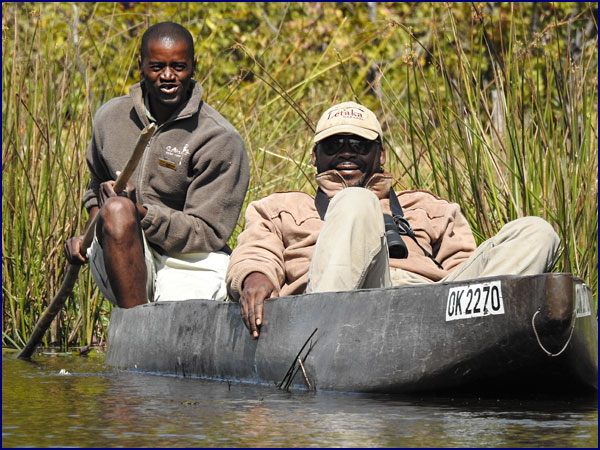
Gee relaxes in a mokoro |
It
was peaceful and serene on the river, and we slowly worked our way
upstream, our guide poling against the current. The channels,
lined with tall reeds and marsh grasses, were choked with lily
pads. Dragonflies hovered above the surface. Our guide instructed
us not to let a hand trail in the water because a crocodile might
grab it; I remembered those powerful jaws and rows of jagged teeth
when we got a close look at that big croc in Chobe. We’re gonna need a bigger boat!
Jacanas walked across
the top of the lily pads; these long legged copper-colored birds
are also known as lily trotters. We got a close-up look at an
open-billed stork, and a goliath heron flew up out of the reeds.
Sally added the rufous-bellied heron and the yellow-throated
petronia to her list; I’m not sure how many she was up to for
the trip, but she was working on number 995 for her life list.
We were drifting along peacefully
when Sally alerted me that the bottom of my photo vest was
dragging in the water; my notebook was drenched, along with my
lens cleaners and everything else in the lower pocket. Oh well,
better than being grabbed by a crocodile! We stopped to examine a
hippo skull on the bank, and then turned around and headed back
downstream, carried on the gentle current.
A family of elephants
came to the shore to drink, lining up in a row with their front
feet in the shallows. We watched from the river, entranced, as
they sucked up water in their trunks and squirted it into their
mouths. They drank for a long while before turning and silently
vanishing into the forest.
On the way back we
came across a large herd of zebra right near the camp, and we
spent some time watching them. A baby, several months old, peeked
around his mother’s rump; he still had his fuzzy baby coat and
it looked like he was wearing striped pajamas. Several adults were
laying down napping under a tree, and one had a good roll in the
dust.
Back
in camp we had a late lunch, and from where we sat at the table we
could watch the zebras. A group of them hung out in the shade of
some nearby trees, scratching each other’s’ backs and withers
amicably. Their course black and white manes stood straight up.
Standing together, they made a dazzling array of stripes.
As we were sitting
around the table, Jineen looked over and saw a vervet monkey
coming out of our tent. Darn, I should have zipped it tighter!
Luckily he didn’t take (or leave) anything. The monkey ran up a
tall tree nearby and looked down at us from a high branch. We
could see an elephant not far from camp, munching on some bushes.
Gee showed us some really nice
baskets that his family had woven from palm leaves. His mother,
aunt, and grandmother had helped put him through school by making
and selling these. They were dyed different earth-tone colors; the
bark of the marula tree was boiled to make the yellow, the roots
of the magic guarri bush for the darker brown, and the tan was
made from the toothbrush tree. We were happy to buy some of the
baskets to take home as souvenirs.
We
went out driving again at four. We stopped to watch an elephant
feeding; he would dig up a plant with his foot, pick it up with
his trunk and shake the dirt off, and then pop it in his mouth. A
hoopoe watched us from a tree branch, tilting his tufted head and
shaking his feathers.
|

Hoopoe
|
We checked on the
wild dogs; they were still sleeping, though they had moved a short
distance. At first only two were in plain sight, but looking
around we found more and more of them sleeping camouflaged in the
bushes until gradually we accounted for all twelve. Every so often
one of the dogs would get up and walk to a new spot and then flop
back down again.
Gee told us that the wild
dogs hunt by sight rather than scent, so they hunt during the day,
usually early morning or near dusk. They are very fast and have
great endurance - they can run for hours. These effective hunters
make a kill almost every day. Their main diet is impala, and they
will pick one target and stay on it, even if another animal
crosses their path. Several
lead dogs will run at top speed after their prey while the others
fan out and follow; then they will switch off as the leaders tire
- this way they wear their quarry down to exhaustion. Gee said
that when an impala sees a lion it will snort a warning to alert
the others; when it sees a dog it doesn’t take the time to sound
the alarm – it just runs as fast as it can!
We were just debating
whether to wait in case the dogs started to hunt or to move on,
when the vehicle from the other Letaka safari came to see the
dogs. Gee arranged for them to radio to us if there was any
action, and we drove on.
We came out to a broad open plain
with a river winding through it, with a few big trees along the
banks. There were large herds of zebra and waterbuck grazing
together, with elephants and wildebeest behind them. It was an
incredible scene, and I tried to capture it with panoramic photos.
We spent some time
watching these animals. The zebras always charm me, with their
roly-poly pony-like bodies and those big round ears. Their striped
manes stand up straight like a Mohawk - Gee said that if you see
one with its mane laying over it is probably sick. The waterbuck
have long soft fur and appear somewhat gentle and cuddly, though
their sharp horns might prove otherwise.
|
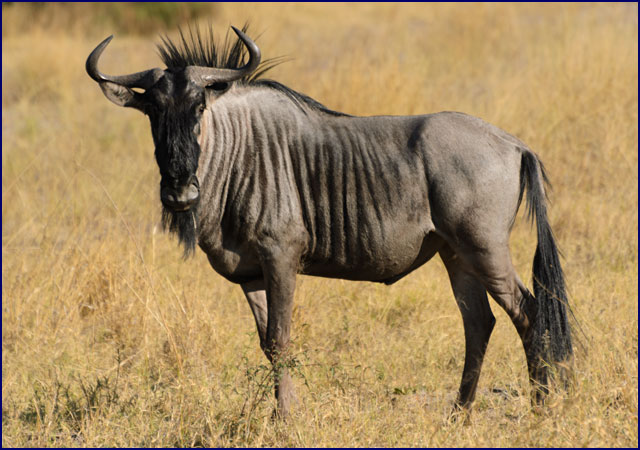
Wildebeest |
In the brilliant
afternoon light, we were able to observe the more handsome
qualities of the wildebeest. Even though they are considered one
of the Ugly Five they
have a certain charm to them. Their necks and shoulders are
patterned with subtle mottled black stripes; Gee explained that
these are actually sweat glands - when they are running and
sweating the black stripes get wider. The females’ heads are
brown on top, while the males’ heads are black.
Then we got the radio call - the
wild dogs were on the move!
|